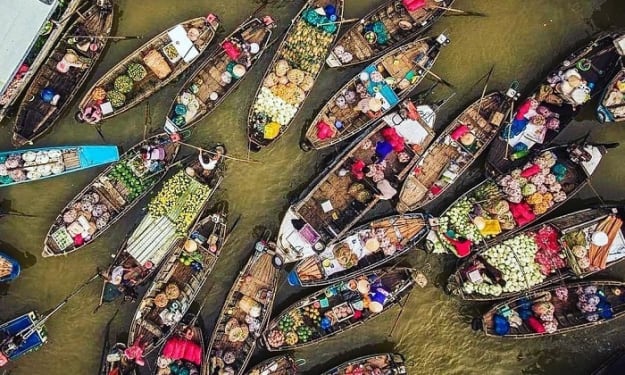5 Things to Know About Peru's Inti Raymi Festival!
Whether you’re planning to attend or simply curious about this fascinating event, here are five essential things to know about the Inti Raymi Festival.

Introduction:
Peru’s Inti Raymi Festival is one of South America's most vibrant and significant cultural celebrations, steeped in history, tradition, and spectacular pageantry. Held annually in the ancient city of Cusco, this festival honors the Inca Sun God, Inti, and marks the winter solstice, which was a critical time for the Inca civilization. Whether you’re planning to attend or simply curious about this fascinating event, here are five essential things to know about the Inti Raymi Festival.
1. A Historical Celebration with Ancient Roots
Origins of Inti Raymi
Inti Raymi, which translates to "Festival of the Sun," is a traditional Inca festival that dates back to the 15th century. Established by Inca Emperor Pachacuti, it was designed to honor Inti, the Sun God, who was considered the most important deity in the Inca pantheon. The festival coincides with the winter solstice, around June 24th, when the sun is furthest from the earth in the Southern Hemisphere. This period was crucial for the Incas, who depended on agriculture and worshipped the sun as a life-giving force.
Historical Significance
For the Incas, Inti Raymi was more than just a celebration; it was a vital religious and astronomical event. The festival was an opportunity to express gratitude for the past year's harvest and to seek blessings for the coming agricultural season. The Incas believed that through their rituals and ceremonies, they could ensure the sun’s return, which was essential for their crops and survival.
Revival of Inti Raymi
The Spanish conquest in the 16th century led to the suppression of indigenous traditions, including Inti Raymi. The festival was banned for centuries, with only secretive and limited observances by indigenous people. It wasn't until 1944 that Inti Raymi was revived and reintroduced as a public celebration, thanks to the efforts of Faustino Espinoza Navarro and local intellectuals. Since then, it has become a prominent cultural event in Cusco, drawing thousands of visitors from around the world.
2. The Grand Spectacle of the Festival
Festival Day Celebrations
The Inti Raymi Festival is renowned for its elaborate reenactments, traditional dances, and colorful costumes. The main celebration takes place on June 24th and is divided into three key parts: the opening ceremony at Qorikancha (the Temple of the Sun), the procession to the Sacsayhuamán fortress, and the grand finale at Sacsayhuamán.
Opening Ceremony at Qorikancha: The festival begins with a morning ceremony at Qorikancha, the most important temple in the Inca Empire, dedicated to Inti. Here, the Inca Emperor, portrayed by an actor, performs rituals and offers symbolic sacrifices to the Sun God.
Procession through Cusco: After the initial ceremony, a vibrant procession winds through the streets of Cusco, featuring participants dressed in traditional Inca attire. The procession is a visual feast, with dancers, musicians, and performers captivating the crowds with their rhythmic movements and melodious tunes.
Grand Finale at Sacsayhuamán: The climax of Inti Raymi unfolds at the majestic Sacsayhuamán fortress, just outside Cusco. This part of the festival involves a dramatic reenactment of ancient Inca rituals, including a simulated sacrifice, offerings to the gods, and prayers for the sun’s return. Thousands of spectators gather to witness the grand spectacle, which culminates with the Inca Emperor’s appeal to Inti for blessings.
Symbolism and Rituals
Every aspect of Inti Raymi is laden with symbolism and ritual significance. The costumes, for example, reflect the social hierarchy and roles within the Inca society. The Inca Emperor wears a golden robe and a headdress adorned with feathers, symbolizing his divine connection to the Sun God. The rituals performed during the festival, such as the offering of chicha (a traditional corn beer) and the simulated sacrifice of a llama, are meant to replicate ancient practices that were believed to ensure prosperity and harmony with nature.
3. The Cultural and Tourism Impact
Cultural Significance
Inti Raymi is more than just a reenactment of historical events; it’s a celebration of Andean identity and heritage. For the local Quechua-speaking communities, the festival is a time to reconnect with their ancestral roots and to celebrate their cultural legacy. It serves as a powerful reminder of the resilience and continuity of Inca traditions, despite centuries of colonization and cultural suppression.
Boost to Tourism
The revival of Inti Raymi has had a profound impact on tourism in Cusco and the surrounding region. The festival attracts thousands of international and domestic tourists each year, contributing significantly to the local economy. Visitors flock to Cusco not only to witness the festival but also to explore the city’s historical sites, including Machu Picchu, which is a short journey from Cusco. The influx of tourists during Inti Raymi creates a bustling atmosphere, with hotels, restaurants, and tour operators benefiting from the increased demand.
Responsible Tourism
While Inti Raymi boosts tourism, it also presents challenges related to sustainability and cultural preservation. Tourists are encouraged to respect local customs, support responsible tourism practices, and engage with the community in a way that honors the festival’s cultural significance. Participating in community-led tours, purchasing locally made crafts, and learning about Inca history from local guides are ways to ensure that tourism benefits the local population and preserves the authenticity of Inti Raymi.
4. Experiencing Inti Raymi: Practical Tips for Visitors
Planning Your Visit
To fully experience Inti Raymi, it’s essential to plan your visit well in advance. The festival takes place on June 24th, but the days leading up to the event also feature various activities and celebrations in Cusco. Here are some practical tips for visitors:
Book Early: Hotels and accommodations in Cusco fill up quickly around the festival dates. It’s advisable to book your stay several months in advance to secure the best options.
Purchase Tickets: While the street processions and some parts of the festival are free to watch, tickets are required for the main event at Sacsayhuamán. Tickets can be purchased online or through local tour operators. Choose from different seating areas based on your budget and desired view.
Acclimate to Altitude: Cusco is located at an altitude of 3,400 meters (11,200 feet) above sea level. To avoid altitude sickness, arrive a few days before the festival to acclimate. Drink plenty of water, avoid strenuous activities initially, and consider medications or natural remedies if you’re prone to altitude sickness.
Festival Etiquette
Inti Raymi is a sacred celebration with deep cultural significance. Visitors should be mindful of their behavior and respectful of the local customs:
Dress Appropriately: Wear comfortable clothing suitable for the weather and be prepared for varying temperatures. Respectful attire that covers shoulders and knees is recommended, especially during visits to religious sites.
Be Respectful: Avoid interrupting or intruding on ceremonies and processions. Always ask for permission before taking photographs of people, and respect any areas that are restricted to tourists.
Support Local Artisans: Purchase souvenirs and crafts from local vendors to support the community. Opt for authentic, handmade items rather than mass-produced goods.
Getting Around
Cusco’s narrow streets and the large influx of visitors can make getting around challenging during Inti Raymi. Here are some tips for navigating the city:
Walking: Many of the festival’s events and attractions are within walking distance in Cusco’s historic center. Wear comfortable shoes and be prepared for cobblestone streets and hills.
Public Transport: Use local buses or taxis for longer distances. Be patient and expect delays due to increased traffic.
Guided Tours: Consider joining a guided tour to enhance your festival experience. Local guides can provide valuable insights into the history and significance of Inti Raymi and help you navigate the crowds.
5. Preserving Inti Raymi for Future Generations
Challenges and Conservation
While Inti Raymi is a celebration of cultural pride and heritage, it faces challenges related to commercialization, overcrowding, and cultural authenticity. The growing popularity of the festival has led to concerns about preserving its integrity and ensuring that it remains true to its historical roots.
Efforts to Preserve Inti Raymi
Several initiatives are in place to address these challenges and ensure the sustainable future of Inti Raymi:
Community Involvement: Local communities play a central role in organizing and performing the festival. Their involvement helps maintain the authenticity of Inti Raymi and ensures that it reflects the values and traditions of the indigenous population.
Educational Programs: Efforts are being made to educate both locals and tourists about the cultural significance of Inti Raymi. Workshops, lectures, and cultural exchanges aim to deepen understanding and appreciation of the festival’s heritage.
Sustainable Tourism Practices: Tourism authorities and local organizations promote sustainable tourism practices, such as responsible waste management, respect for cultural norms, and support for local businesses. These practices help mitigate the environmental impact of increased tourism and preserve the festival’s cultural legacy.
The Future of Inti Raymi
As Inti Raymi continues to evolve, its success will depend on balancing tourism with cultural preservation. By fostering a deep respect for Inca traditions and involving local communities in the festival’s organization, Inti Raymi can remain a vibrant and meaningful celebration for future generations.
Conclusion
The Inti Raymi Festival is a captivating blend of history, culture, and tradition that offers a unique glimpse into the rich heritage of the Inca civilization. From its ancient origins to its modern-day revival, Inti Raymi stands as a testament to the enduring legacy of the Inca people and their profound connection to the Sun God, Inti. For visitors, it’s an unforgettable experience that combines spectacular pageantry with deep cultural significance. By understanding the festival’s history, respecting local customs, and supporting sustainable tourism practices, you can fully appreciate the magic of Inti Raymi and contribute to its preservation for years to come.
About the Creator
ED CLEFF
I have over a decade of experience in crafting compelling and diverse content. My portfolio spans multiple industries, including technology, healthcare, finance, and lifestyle, given me an added advantage in all my areas of specialization.
Enjoyed the story? Support the Creator.
Subscribe for free to receive all their stories in your feed. You could also pledge your support or give them a one-off tip, letting them know you appreciate their work.






Comments (1)
Wow, wow, it was fabulous ED! Love to read about South American one! Very nice culture it is!